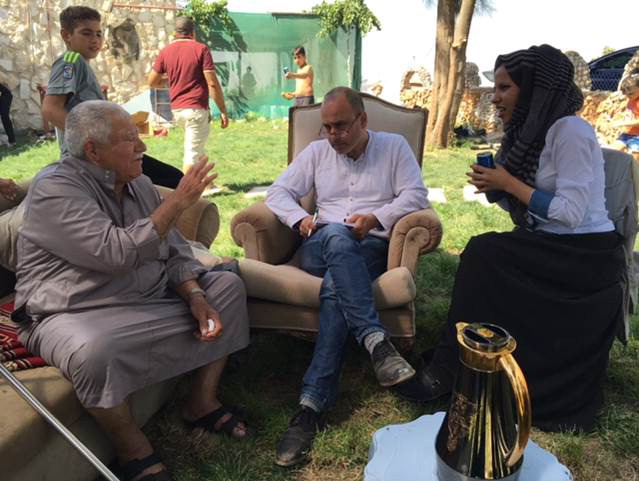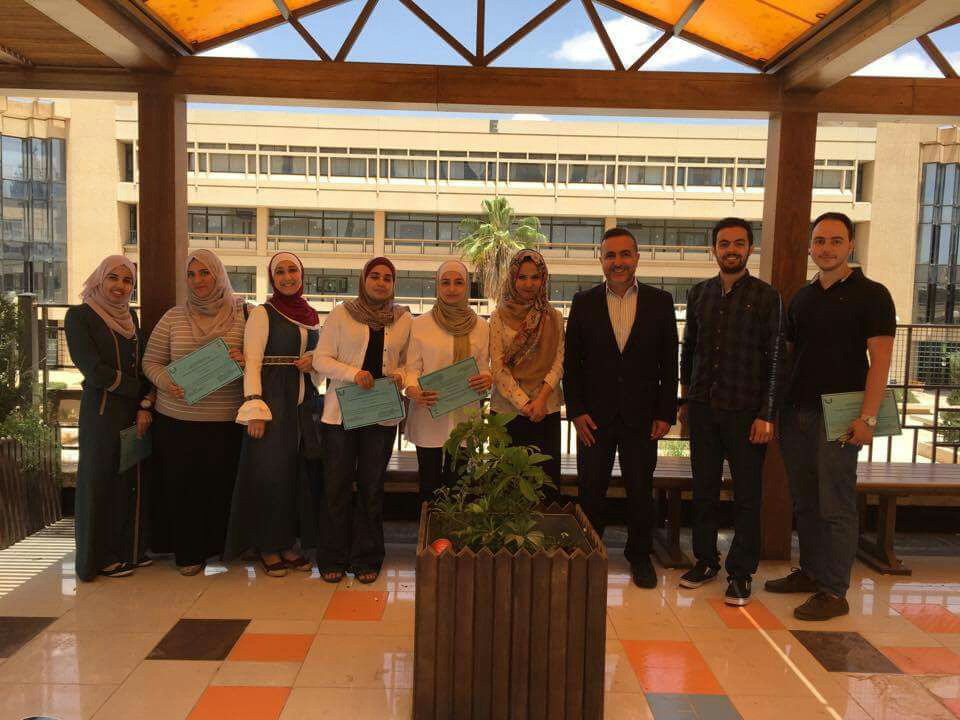|
Cycle 3 (2014 Deadline) Enhancing water education at the university level in Jordan by incorporating an innovative multi-agent modeling and analysis tool U.S. Partner: Steven M. Gorelick, Stanford University
Project Dates: September 2014 to October 2017  | | Dr. Daanish Mustafa is writing notes as Eng. Elham El Shorofat translates. In the picture also, is Abu Kishk, his son and grandson in the background, a Jordanian farmer since the 1950s. The interview focused on the historical setting of agro-business and how laws, regulations and changing circumstances have shaped agriculture in Jordan as we see it today. This interview took place in his farm in Mafraq |
Adaptation of water resources planning techniques into a class-teaching setting is challenging and requires accurate procedures. Previous water resource studies in Jordan inspected particular hydrologic elements and suggested potential strategies, but there have been no comprehensive water policy evaluation tools. In all previous efforts, representation of the multifaceted institutional environment that constrains interactions among water users, distributors, and managers has been either absent or highly generic. The research team of the Jordan University of Science and Technology (JUST) will create a teaching and a training module based on the model produced by the U.S. partner, which will be incorporated into a university course and a training workshop for water professionals. The modules will be used by the students and water professionals to evaluate and compare a diverse set of water-policy interventions that can be short or long-term. Short-term scenarios will be used to explore institutional modifications. For the long-term horizon, the large infrastructure projects such as the Red-Dead Sea project will play a dominant role. Based on the results of the scenario and policy intervention analysis, alternative freshwater resources strategies will be identified that prioritize policy alternatives to enhance sustainability and security of Jordan’s freshwater system, taking into account the broad range of future environmental and socioeconomic possibilities. The project is anticipated to strengthen higher education at JUST and workforce development in water programs, which will contribute to economic growth in Jordan. The incorporation of the multi-agent model in class teaching is expected to foster innovation in education and develop new learning materials and methods. The research project also aims to improve water resource management and contribute to reforming governance and regulations to equitably share access and defuse competition, as well as strengthen the resilience and response to disasters in order to help Jordan adapt to a changing climate. The tools developed by this project will enable decision makers and professionals to mitigate and adapt to the effects of climate change, so Jordan can grow without harming the environment while strengthening its resilience to warmer temperatures and weather shocks. The format of this work is focused on education to an audience that is primarily female students; as a result, the role of women and girls throughout the duration of the project will be enhanced. This project meets USAID's development goals in education and water and is also expected to have an impact on women’s empowerment, food security, and climate change. The output of the U.S. partner’s project will be used by the research project team for education and training in Jordan and the Middle East, which will ensure the dissemination of the new technology. Final Summary of Project Activities
 | | Pictures taken at the end of the Masters Students Training Program- April 30, 2017 [Photos courtesy of Dr. Talozi] |
The main developmental target of this PEER project was education. The team aimed to enhance education methods with the utilization of new and sophisticated models and hydroinformatic tools, in order to upgrade courses from merely theoretical content to hands-on application type of courses. Hydroinformatic tools were integrated into the curriculum of GIS and water resources undergraduate classes and a graduate-level course was also created. GIS, SWAT and WEAP tools were implemented in new educational content thus enhancing and upgrading educational methodology and practice. The goal to enhance courses with local content in order to create more awareness about water and environmental issues in Jordan was also successfully completed. While most course content is based on international text-book examples and data, the research team designed and created educational content based on local data and experience, thus, enhancing the awareness and experience of students in a local context and issues as previously there was a dis-connect between water courses and local water problems and issues. Six modules were designed to cover various geographical areas of Jordan including: the Yarmouk River Basin, the Zarqa River Basin, the four northern governorates of Jordan namely: Irbid, Jerash, Ajloun and Mafraq. The modules were also created to cover Surface and Groundwater issues. Furthermore, 3 modules were designed to inform policy and decision makers. The WEAP module was designed to allow students and professionals to run various scenarios such as population growth, climate change, to allow students to see the role of hydroinformatic tools in guiding and advising sound water policy in Jordan. Two modules, 5 and 6, target groundwater protection and management. Module 5 demonstrated the varying rates of groundwater vulnerability to contamination, thus guiding planning for various land use activities. In module 6, multi-criterion analysis was used to select the optimal location for a landfill - one criterion was to minimize harm to groundwater. |
|
|
|





